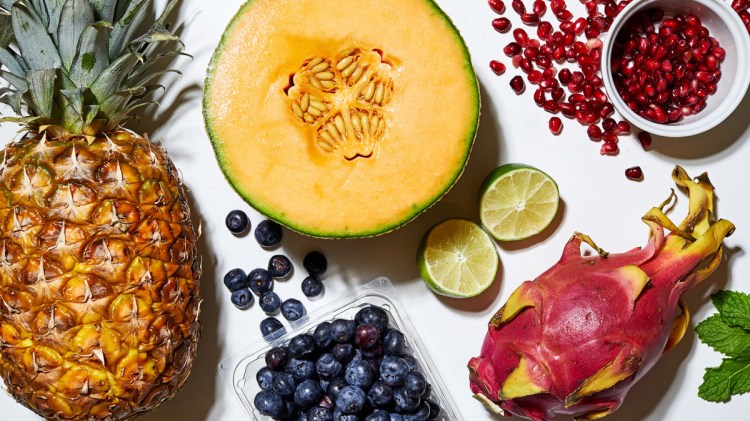Admittedly, fruit salad might not be something your friends and family would swoon over. After all, some of us remember the syrupy canned concoctions of our youth. Maybe the mere mention of it conjures a bunch of random fruit thrown into a bowl. There is room for improvement.
Here are a few tips on how to upgrade the flavor and appearance of your next fruit salad, without a tremendous amount of effort or expense.
• Mix things up. The last thing you want to do is put out a giant bowl of just one kind of cut-up fruit, unless you have some of the most perfect strawberries or cherries – in which case, I’m listening. We talk about the Rule of Three elsewhere, so why not here? One type of fruit is boring, two looks like you couldn’t be bothered, but three – well, you’ve put in some effort. I’m willing to go up to four or five, especially when one or two are components such as berries that require little prep.
Think about variety in terms of color, flavor, texture and size. With fruit, color is easy. Your options are a veritable rainbow. Just be sure to provide a flavor range from sweet to tart, as well as a mix of firm and soft textures. You could even incorporate some crunch in the form of pomegranate seeds (tart/colorful, check). Your personal preference may vary, but I like a fruit salad with different size pieces; otherwise, it feels too formal and looks too much like salsa.
• Freeze – or heat – some of the fruit. Popping some of the fruit in the freezer in advance lends textural interest (see above) and also can help keep the salad at a refreshingly cool temperature for serving. Frozen grapes are delightful, and I’m partial to eating mango straight out of the freezer. Berries or even bananas, which tend to go brown when cut up and stirred into something at room temperature, are other possibilities. Or you can go the opposite direction and grill some (or all) the fruit, which caramelizes the sugars and imparts a pleasant smoky flavor, and adds attractive grill marks. Prime candidates for grilling include pineapple, watermelon and peaches, because they hold their shape.
• Accent with something unexpected. I like using sturdy, relatively affordable and easy-to-prepare fruits as the base of my fruit salad. Good options include cantaloupe, honeydew and pineapple. Then I start mixing in a variety of small, tender ones, such as blueberries, cherries, peaches and plums.
It’s also fun to add one splurge fruit, something that can be more exotic or unexpected, something that you would not want as the entire foundation of your salad. Dragon fruit, which boasts a spongy flesh speckled with tiny black seeds and a kiwilike flavor, is one example. Other possibilities: star fruit, kiwi berries and fresh currants from the farmers market. Be sure you keep at least some of your splurge fruit on top for visual panache.
• Add extra flavor. Beautiful, ripe fruit is worth appreciating on its own. If you’re making a fruit salad, extra flavoring can bring everything together or improve fruit that is less than perfect. You can do this in several ways.
For a boost of sweetness, use a simple syrup flavored with herbs or citrus zest/peel. Bring equal parts of water and sugar to a boil, cook until the sugar has dissolved, and then remove from the heat. Add your herbs or citrus to steep for half an hour. Discard the solids before using or storing.
For a fruit salad, herbs such as mint, basil and culinary lavender work well. Vanilla beans and ginger can be used similarly. Another strategy I’ve cribbed from Cook’s Illustrated involves muddling chopped herbs (citrus zest would be nice, too) with a bit of sugar and vanilla extract in the bottom of the serving bowl and then adding the fruit before stirring it all together. You can also flavor your salad with fresh citrus juice or zest.
Don’t shy away from the heat of spices, either. A bit of cayenne pepper or minced chile pepper can be an excellent foil for an overall sweet dish.
• Prep, but not too far ahead. Mushy and soupy is not a good look for a fruit salad. Sturdy, firm fruit can be cut up and even combined at least a day in advance, but leave soft fruits that may also bleed color (berries, peaches, etc.) for last-minute prep and assembly. Salads flavored with a simple syrup or herbs muddled in sugar need at least half an hour or up to a few hours for the flavors to combine.
Copy the Story LinkSend questions/comments to the editors.



Success. Please wait for the page to reload. If the page does not reload within 5 seconds, please refresh the page.
Enter your email and password to access comments.
Hi, to comment on stories you must . This profile is in addition to your subscription and website login.
Already have a commenting profile? .
Invalid username/password.
Please check your email to confirm and complete your registration.
Only subscribers are eligible to post comments. Please subscribe or login first for digital access. Here’s why.
Use the form below to reset your password. When you've submitted your account email, we will send an email with a reset code.